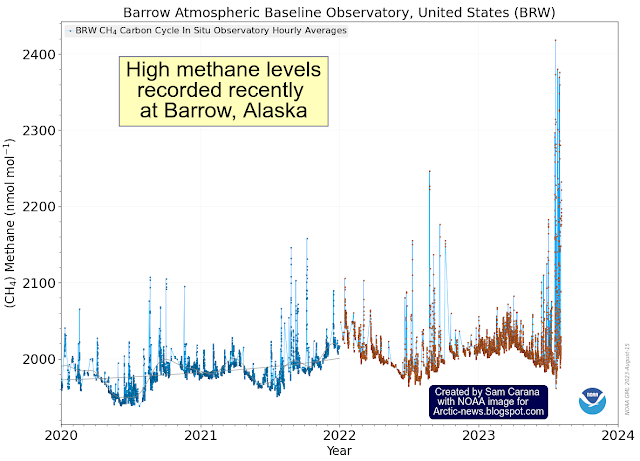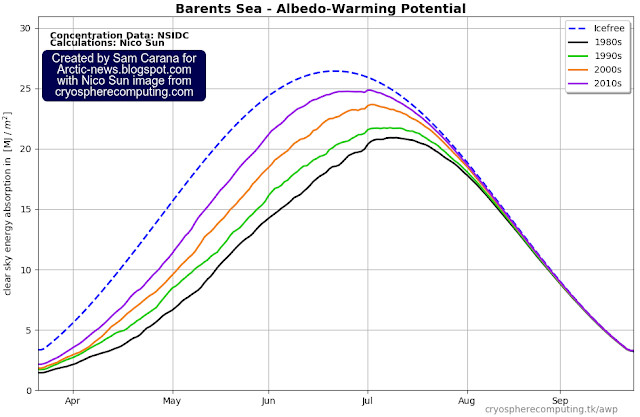The bold black line at the top of the image below, adapted from Climate Reanalyzer, shows extremely high sea surface temperatures up to September 13, 2023, much higher than in any previous year on record.
The image below, created with NASA data, shows why these extremely high sea surface temperatures are so worrying. The image shows monthly mean global surface temperature anomalies (open ocean) vs 1901-1930. The ochre trend, based on January 1900-August 2023 data, indicates the latent heat tipping point was crossed in 2021 and the seafloor methane tipping point could be crossed in 2033. The red trend, based on August 2008-August 2023 data and better reflecting variables such as El Niño, indicates that the seafloor methane tipping point could be crossed late 2023. Data show the seafloor methane tipping point was reached in August 2023.
The latent heat tipping point is estimated to correspond with a sea surface temperature anomaly of 1°C above the long term average, 1901-1930 on the above image, as discussed in earlier posts such as this one.
Sea ice constitutes a latent heat buffer, consuming incoming heat as it melts. While the ice is melting, all energy (at 334 J/g) goes into changing ice into water and the temperature remains at 0°C (273.15K or 32 °F). Once all ice has turned into water, all subsequent energy goes into heating up the water, and will do so at 4.18 J/g for every 1°C the temperature of the water rises.
 |
| [ The Latent Heat Buffer ] |
The latent heat tipping point has meanwhile been crossed. Loss of this buffer is linked to the seafloor methane tipping point, i.e. the point where additional heat reaches the seafloor and destabilizes hydrates contained in sediments at the seafloor. This tipping point comes with multiple self-reinforcing feedback loops, such as explosive growth in methane volume setting off further destabilization, rapid rise of Arctic temperatures, loss of permafrost and loss of albedo, and release of further greenhouse gases.
Crossing of the seafloor methane tipping point will occur later than crossing of the latent heat tipping point, i.e. the seafloor methane tipping point corresponds with a higher ocean temperature anomaly, estimated to correspond with a sea surface temperature anomaly of 1.35°C above the long term average.
The danger is that additional heat will destabilize hydrates in these sediments, leading to explosive eruptions of methane, as its volume increases 160 to 180-fold when leaving the hydrates, and resulting in huge eruptions of methane both from the destabilizing hydrates and from methane that is present in the form of free gas underneath the hydrates.
 |
| [ from earlier post, click on images to enlarge ] |
The above image, from an earlier post, illustrates that warnings have been given before about the danger of these two tipping points getting crossed in the Arctic. In the above image, the trends are based on annual sea surface temperature data for the Northern Hemisphere. The seafloor methane tipping point is estimated to correspond with ocean temperature anomalies reaching 1.35°C above the long term average.
 |
| [ Latent heat loss, feedback #14 on the Feedbacks page ]
|
 |
| [ click on images to enlarge ] |
The situation is dire and is getting more dire every day, which calls for a Climate Emergency Declaration and implementation of comprehensive and effective action, as described in the Climate Plan with an update at Transforming Society.
• Climate Reanalyzer - daily sea surface temperature
https://climatereanalyzer.org/clim/sst_daily
• NASA - GISS Surface Temperature Analysis
• NOAA - Barrow Atmospheric Baseline Observatory, United States
https://gml.noaa.gov/dv/iadv/graph.php?code=BRW&program=ccgg&type=ts
• NOAA - MetOp satellite records
https://www.ospo.noaa.gov/Products/atmosphere/soundings/heap/iasi/iasiproducts.html
• NOAA - N20 satellite records
https://www.ospo.noaa.gov/Products/atmosphere/soundings/nucaps/NUCAPS_composite.html
• Two Tipping Points
https://arctic-news.blogspot.com/2023/08/two-tipping-points.html
• Sea surface temperature at record high
https://arctic-news.blogspot.com/2023/03/sea-surface-temperature-at-record-high.html
https://arctic-news.blogspot.com/p/albedo.html
• Latent Heat
https://arctic-news.blogspot.com/p/latent-heat.html
• The Threat of Global Warming causing Near-Term Human Extinction
https://arctic-news.blogspot.com/p/threat.html
• FAQ
https://arctic-news.blogspot.com/p/faq.html
• Feedbacks
https://arctic-news.blogspot.com/p/feedbacks.html
• Climate Plan
https://arctic-news.blogspot.com/p/climateplan.html
• Transforming Society
https://arctic-news.blogspot.com/2022/10/transforming-society.html
• Climate Emergency Declaration
https://arctic-news.blogspot.com/p/climate-emergency-declaration.html







































